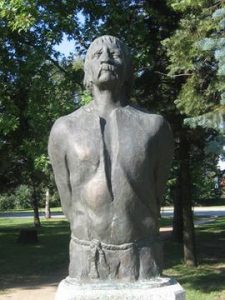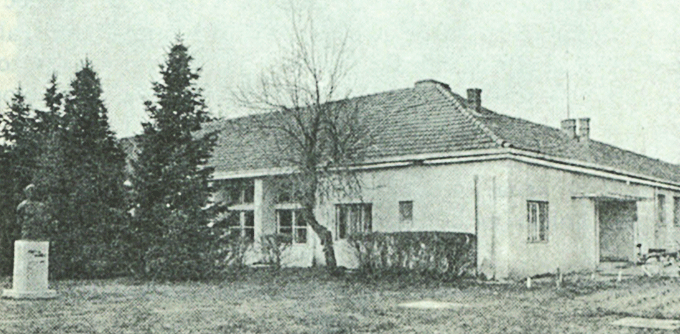Our small presentation
Presented by: Branko Stantić. Editor: Miroslav Popović. Music: Momačko kolo - Bunjevačka igra.
School through history
The history of education in Tavankut can be traced back to 1847, when the People's Municipality of Subotica decided to establish an elementary school in the village of Tavankut. The school was not permanent, and teachers occasionally came to the village and gathered pupils in a room that also had other purposes.
Two years later, the classes began to be organized in the language used by the people. The first permanent elementary school, under the name "Saint Anna", was opened in 1850. The new school building, with one classroom and a teacher's apartment, was built ten years later. At that time, the school had around one hundred students.
In the second village called Ljutovo, a school was also built in 1877. It was named "Old Ljutovo". This school building is still in use today.
In the center of the village of Tavankut, a third school building was built in 1890. The education process was organised there until 1957 when a new eight-year school building was built.
» More
After the First World War, a more dynamic development of education continued and in 1929 in the center of Tavankut, a new school was built next to the already existing building. In addition to the classrooms, there was also a bathroom with showers for students, but in 1950 it was turned into a teacher's apartment.
In 1952, an eight-year school was established and it initially used existing school buildings, but also the premises of the village clinic because the school facilities were not sufficient.
A part of an eight-year school with four classrooms, two offices and a chamber, was built in 1954. The school is located in the center of the village so that students come from the surrounding area, and some of them have to cross seven kilometers to get to school every day.
The education process was organised in the Serbo-Croatian language dating back to 1952, ie. to the establishment of the school. The school has borne the name of Matija Gubec since 1956. The eight-year school "Matija Gubec" was established in 1961 by merging the schools that had worked in the Tavankut area.
The building where the Elementary School "Matija Gubec" is located today was built after the Second World War and it completely matched the needs of the educational process in 1980.
The school today consists of three separate buildings for the educational process in Ljutovo, Gornji Tavankut and Donji Tavankut. The first major task in elementary education was the struggle for the full inclusion of children in the four-year, and later eight-year education. The school has always cooperated with partner schools that also bear the name of Matija Gubec, in the form of pupils' and teachers' visits and various events. In 1970 the school took a group of students for the first time on a holiday organised in its own resort Grljevac near Split. The school cooperative "Nemirna ravnica" also dates from that period and through its work, students and teachers successfully engaged in agricultural activities. The optional teaching of the Hungarian language as the language of the social environment was introduced in 1972.
» Less
About the school's name

Ana Beslic: Monument to Matija Gupac in Lower Tavanku
Matija Gubec, the real name was Ambroz, is the most famous among the people of the Croat-Slovenian peasant rebellion in 1573. A native of Hižakac near Stubičke Toplice, life ended at the aforementioned historical event, after suffering and destroying. He is also considered a fictitious person, and is mentioned and marked by various literary, dramatic and artistic works. Through various political and social occasions, it is referred to as a political symbol in various ideologies, movements and interests that want to come closer to an ordinary "little" man. He is considered the greatest Croatian national hero.
Matija Gubec was an unskilled peasant, exceptional ability of a quality leader. His heartfelt, sincere and noble motives, organizational and tactical skills, still today are a source of respect and inspiration to different people.
» More
The Gubec was the inkville on the Stubic monastery of Franjo Tahi, a farmer without his own country. In history he was remembered as one of the main founders of the secret peasant alliance in Stubica in Hrvatsko Zagorje.
After the authorities ignored the invitation to help peasants who could not live normally and peacefully because of the increase in the rent and terror of Franjo Tahi, the idea of launching a peasant rebellion was born. During the rebellion itself in 1573, he was the commander of the peasant army, which is why he was probably proclaimed a peasant king. He was awarded the title "Beg" in the nation.
The bun started in the night between January 27th and 28th, 1573, by attacking Cesargrad Castle at the neighborhood-stubic monastery in today's Klanjac. About sixty Croatian and Slovenian landowners were divided into the leadership of Matija Gupc, Ivan Pasanc and Ilija Greguric. The bows in Slovenia and the area between Sava and Kupa are quickly shut down.
Gubec won the fortified Šabac curia near Krapina. It was precisely the resistance provided by the minority of poorly armed Gupc's peasants that was so strong that feudal lords were forced to seek help. Ban Draskovic gathered the army in Zagreb to suppress the uprising in Zagorje.
They were defeated in the final battle near Stubičke Toplice on February 9, the same year. After that, in Zagreb, on the Square of St. Mark, Matija were crowned with a glowing crown in front of the eyes of the people, tortured and ultimately razedvorili.

Oton Ivekovic: The expulsion of Matija Gupca in the square in front of the church of St. Mark in Zagreb
Gupchek's greatest success is certainly the conduct of the first rebellion of a common oppressed people against the possessions. With his heroism and the desire for justice, many politicians, artists, and each of us are impressed today. How much is respected by people from different milieu is evidence that the so-called. Gupč's linden tree, the multicellular tree in Gornja Stubica, became a protected cultural monument, because according to the folk tradition Gubec gathered its followers near it.
Gubec served as an inspiration to many artists, both through literature (the novel by Seljačka buna A. Šenoe, drama Matija Gubec M. Bogović), music (opera Matija Gubec I. Lhotka Kalinski, the first Croatian opera opera Gubec-beg I. Krajač, K. Metikoš and M. Prohaska), painting (paintings by O. Iveković and F. Quiqerez), sculpture (a monument in the Upper Stupa A. Augustinčić) and a film (Peasant Revolution of 1573 V. Mimice).
Also, his name is carried by many cultural and artistic societies. It is interesting that according to the research dr. Slavenica Letice is the largest number of Croatian streets named after Matija Gubac.
During the Kingdom of Yugoslavia, a postage stamp with his image was issued, while in the edition "Croatian history in the comic book", Večernji list, the main hero of the first comic was Gubec.
It is also important to emphasize the two-day manifestation "Seljačka buna", which has been held since 2008 in Donja Stubica, organized by the Family of the Knights of the Golden Chalice from Donja Stubica.
All these are the names of Gupč's characters and works, they are a clear proof of how much is appreciated in the nation and how after so many times he inspires different people, different times, lifestyles and beliefs.
» Less









